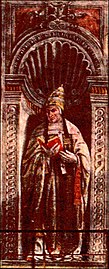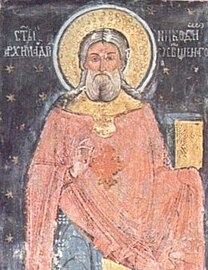December 26 (Eastern Orthodox liturgics)
Appearance

December 25 – Eastern Orthodox liturgical calendar – December 27
All fixed commemorations below are observed on January 8 by Orthodox Churches on the Old Calendar.[note 1]
For December 26th, Orthodox Churches on the Old Calendar commemorate the Saints listed on December 13.
Feasts
[edit]- Second Day of the Feast of the Nativity.[1][2][note 2]
- Synaxis of the Most Holy Theotokos.[1][3][4][note 3]
- Commemoration of the Flight into Egypt of the Most Blessed Theotokos.[5]
- Commemoration of Saint Joseph, King David and Saint James.[6]
Saints
[edit]- Saint Archelaus, Bishop of Harran in Northern Mesopotamia (c. 280)[1][7][note 4]
- Saint Zeno (Zenon), Bishop of Maiuma (the port of Gaza), in Palestine (4th century)[1][7][note 5]
- Venerable Evaristus (Evarestos), Monk of the Studion Monastery (825)[1][9][10]
- Hieromartyr Euthymius of Sardis (Euthymios the Confessor), Bishop of Sardis (840)[1][11][12][13][note 6]
- Venerable Constantine, Monk of Synnada, the former Jew (9th century)[1][14][15]
Pre-Schism Western saints
[edit]- Saint Dionysius, Pope of Rome (268)[16][note 7]
- Saint Marinus, the son of a senator in Rome, he was martyred by beheading under Numerian (283)[16][note 8]
- Saint Zosimus, a Greek Pope of Rome (418)[16]
- Saint Tathai (Tathan, Tathaeus, Athaeus), Abbot of Llantathan (early 6th century)[7][16][note 9][note 10]
- Saint Jarlath, first Bishop of Tuam, founder of the monastery of Cluain Fois, near Tuam (Ireland) (c. 540)[1]
- Saint Theodore the Sacrist, a holy man and contemporary of St Gregory the Great in Rome (6th century)[16][note 11]
- Saint Amaethlu (Maethlu); a church founded by him in the village of Llanfaethlu in Anglesey, Wales, is named after him (6th century)[16]
Post-Schism Orthodox saints
[edit]- Saint Nicodemus of Tismana, Romania (1406)[1]
- New Hieromartyr Constantius the Russian, Priest at Constantinople, by beheading (1743)[1][18]
New martyrs and confessors
[edit]- New Hieromartyrs Alexander and Demetrius, Priests (1918)[7][13]
- New Hieromartyrs Nicholas, Michael, and Nicholas, Priests, and Michael, Deacon (1930)[7][13]
- New Hieromartyr Leonidas (Antoshchenko), Bishop of Mariisk (1937)[1][13]
- New Hieromartyr Basil (Mazurenko), Hieromonk (1937)[1][13]
- Hieromartyr Alexander, Priest (1937)[7][13]
- New Martyr Augusta (Zashchuk), Schema-Nun (1937)[1]
- Virgin Martyrs Anthisa and Makaria (1937)[7][13]
- New Hieromartyr Andrew, Bishop of Ufa (1937)[7][19]
- New Martyr, Valentina, (1937)[7][19]
- Venerable New Hieromartyr Isaac II (Bobrikov), Archimandrite of Optina Monastery (1938)[1][7][13][19][20][note 12]
- New Hieromartyr Gregory, Priest (1938)[7][13]
- Virgin Martyrs Augusta and Mary (1938)[7][13]
- Martyr Agrippina (1938)[7][13]
Other commemorations
[edit]- Repose of Abbot Barlaam of Valaam and Optina Monasteries (1849)[1]
- Repose of Archimandrite Irenarchus (Rosetti) of Mt. Tabor (1859)[1]
- Repose of Elder Serapheim Savvaitis, Hegumen of the Holy Lavra of Saint Sabbas the Sanctified (2003)[21][note 13]
Icons
[edit]- Icon of the "Mother of God of "Vilna" ("Vilen-Ostrabramsk", "Our Lady of the Gate of Dawn").[22][23]
- Icon of the Mother of God "the Three Joys".[19][24][25][note 14]
- Icon of the Mother of God "Merciful" (Greek: Eleousa).[19][26][note 15]
- Icon of the Mother of God "the Blessed Womb" or "Barlovsk" (1392)[19][27][note 16]
- Icon of the Mother of God "Baibuzsk" (Baibuskaya) (1852)[7][19][note 17]
Icon gallery
[edit]-
Synaxis of the Theotokos
(Kirillo-Belozersk Monastery, 15th–16th centuries) -
The Flight into Egypt.
(Saint Catherine's Monastery, Mount Sinai) -
Ukrainian icon of the Flight into Egypt; the bottom section shows the idols of Egypt miraculously falling down before Jesus and being smashed (17th century).
-
Pope Dionysius (259–268).
(Fresco in Sistine Chapel, Vatican) -
Stained glass window depicting Saint Jarlath (1961).
-
St. Nicodemus of Tismana, Romania.
-
Icon of the "Mother of God of "Vilna"
(Our Lady of the Gate of Dawn, Vilnius) -
Icon of the Mother of God "the Blessed Womb [ru]" or "Barlovsk" (1392).
Notes
[edit]- ^ The notation Old Style or (OS) is sometimes used to indicate a date in the Julian Calendar (which is used by churches on the "Old Calendar").
The notation New Style or (NS), indicates a date in the Revised Julian calendar (which is used by churches on the "New Calendar"). - ^ On the day after the Nativity of Christ we celebrate the Synaxis of the Most Holy Theotokos, and come together to give her glory and praise. This is the second day of the three-day Winter Pascha.[2]
- ^ The Synaxis of the Most Holy Theotokos: On the second day of the feast, the Synaxis of the Most Holy Theotokos is celebrated. Combining the hymns of the Nativity with those celebrating the Mother of God, the Church points to Mary as the one through whom the Incarnation was made possible. His humanity—concretely and historically—is the humanity He received from Mary. His body is, first of all, her body. His life is her life. This feast, the assembly in honor of the Theotokos, is probably the most ancient feast of Mary in the Christian tradition, the very beginning of her veneration by the Church.[4]
- ^ "In Mesopotamia, St. Archelaus, a bishop celebrated for learning and sanctity."[8]
- ^ "At Majuma, St. Zeno, bishop."[8]
- ^ St Euthymius is also commemorated on March 8.[12] In certain Synaxaria his memory is also celebrated on October 11.[11]
- ^ A priest chosen as Pope of Rome in 259, he restored the Roman Church after the persecution of Valerian, opposed Sabellius and condemned Paul of Samosata.
- ^ "At Rome, St. Marinus, senator. In the time of the emperor Numerian and the prefect Marcian, he was arrested for the Christian religion, racked and torn with iron hooks like a slave, then thrown into a burning pan; but being delivered because the fire became like dew, he was exposed to the beasts without being injured by them, and finally being led again to the altar, the idols of which toppled over at his prayer, he was struck with the sword, and thus obtained the triumph of martyrs.[8]
- ^ A hermit who settled in Glamorgan in Wales where he founded a monastery called St Athan's.[16]
- ^ "TATHAI, sometimes called TATHAR, and in Latin ATHEUS, was a native of Ireland, who came to Britain in order to leave all he had in the world, and lead a solitary life. It appears that he first lived as a hermit in the mountains of Wales, but afterwards established a monastery at Llantathan. From thence he was invited by Caradoc, King of Gwent, to make his abode at Caergwent, or Chepstow, in which place he is said to have founded a school and college. It is doubtful in which of these places he closed his holy life, but his memory was held in great veneration in England as well as in Wales."[17]
- ^ At Rome, St. Theodore, sacristan of St. Peter's church, who is mentioned by Pope Gregory.[8]
- ^ The Moscow Patriarchate authorized local veneration of the Optina Elders on June 13, 1996, glorifying them for universal veneration on August 7, 2000.[20]
- ^ Schema-Archimandrite Serapheim (Travassaros) of the Holy Lavra of St. Sabbas the Sanctified (Bethlehem), also Serapheim Savvaitis the "Elder of the Desert", 1900 – January 8, 2003, was the Igumen and Spiritual Father of the Holy Lavra of Saint Sabbas the Sanctified in Palestine from 1957-2003, and the founder of the Holy Sanctuary of the Shepherds in Beit Sahour (a Metochion of the Holy Lavra of St. Sabbas, begun in 1971 and consecrated in 1989). He was buried in the Lavra of Saint Savvas which he served for more than 70 years. Elder Seraphim had been recently honored by Patriarch Irenaios of Jerusalem with the Order of the Grand Cross (Greek: Μεγαλόσταυρος).
- ^ "The Three Joys" is possibly of western origin, since it depicts the Mother of God, Christ, and St Joseph together. Normally, St Joseph is not depicted in close proximity with the Virgin and Child, since he was not Christ's earthly father. In the icon of the Nativity, for example, St Joseph is not part of the scene within the cave.[24]
- ^ The Icon of the Mother of God, named the "Merciful" ("Kykkiotisa", "Milostivaya"): This icon was written, according to tradition, by the holy Evangelist Luke. It received its name "Kykkiotisa" from Mount Kykkos, on the Island of Cyprus. Here it was situated in an imperial monastery, in a church named after it.
- ^ There are at least four distinct types of the "Blessed Womb" Icon. The Barlov Icon is a variant of the Hodigitria Icon. It appeared on December 26, 1392, and it is in the Annunciation Cathedral in Moscow.[27]
- ^ The BAYBUZSKAYA icon of the Mother of God - is commemorated on December 26, commemorating the transfer of the miraculous image of Baybuz [ru] Kiev province, Chigirinsky county, in place of its appearance, the Kiev Pechersk Lavra, where the image is located to this day. (in Russian): БАЙБУЗСКАЯ икона Божией Матери - празднование ее 26-го декабря, в память перенесения чудотворного образа из Байбуз Киевской губ., Чигиринского уезда, на место ее явления, в Киево-Печерскую лавру, где образ находится и доныне.[28]
References
[edit]- ^ a b c d e f g h i j k l m n o p December 26/January 8. Orthodox Calendar (PRAVOSLAVIE.RU).
- ^ a b Second Day of the Nativity of our Lord. OCA - Feasts and Saints.
- ^ Great Synaxaristes: (in Greek): Σύναξις Ὑπεραγίας Θεοτόκου. 26 Δεκεμβρίου. ΜΕΓΑΣ ΣΥΝΑΞΑΡΙΣΤΗΣ.
- ^ a b Synaxis of the Most Holy Mother of God. OCA - Feasts and Saints.
- ^ Great Synaxaristes: (in Greek): Ἡ Φυγὴ Στὴν Αἴγυπτο τῆς Ὑπεραγίας Θεοτόκου. 26 Δεκεμβρίου. ΜΕΓΑΣ ΣΥΝΑΞΑΡΙΣΤΗΣ.
- ^ "26 ДЕКАБРЯ - Древо". drevo-info.ru (in Russian). Retrieved 2023-05-19.
- ^ a b c d e f g h i j k l m n January 8 / December 26. HOLY TRINITY RUSSIAN ORTHODOX CHURCH (A parish of the Patriarchate of Moscow).
- ^ a b c d The Roman Martyrology. Transl. by the Archbishop of Baltimore. Last Edition, According to the Copy Printed at Rome in 1914. Revised Edition, with the Imprimatur of His Eminence Cardinal Gibbons. Baltimore: John Murphy Company, 1916. pp.397–398.
- ^ Great Synaxaristes: (in Greek): Ὁ Ὅσιος Εὐάρεστος. 26 Δεκεμβρίου. ΜΕΓΑΣ ΣΥΝΑΞΑΡΙΣΤΗΣ.
- ^ Venerable Evarestus of the Studion Monastery. OCA - Feasts and Saints.
- ^ a b Great Synaxaristes: (in Greek): Ὁ Ἅγιος Εὐθύμιος ὁ Ὁμολογητής. 26 Δεκεμβρίου. ΜΕΓΑΣ ΣΥΝΑΞΑΡΙΣΤΗΣ.
- ^ a b Hieromartyr Euthymius the Bishop of Sardis. OCA - Feasts and Saints.
- ^ a b c d e f g h i j k (in Russian) 26 декабря (ст.ст.) 8 января 2013 (нов. ст.). Русская Православная Церковь Отдел внешних церковных связей. (DECR).
- ^ Great Synaxaristes: (in Greek): Ὁ Ὅσιος Κωνσταντῖνος ὁ ἐξ Ἰουδαίων. 26 Δεκεμβρίου. ΜΕΓΑΣ ΣΥΝΑΞΑΡΙΣΤΗΣ.
- ^ Venerable Constantine of Synnada. OCA - Feasts and Saints.
- ^ a b c d e f g December 26. Latin Saints of the Orthodox Patriarchate of Rome.
- ^ Rev. Richard Stanton. A Menology of England and Wales, or, Brief Memorials of the Ancient British and English Saints Arranged According to the Calendar, Together with the Martyrs of the 16th and 17th Centuries. London: Burns & Oates, 1892. p.608.
- ^ Great Synaxaristes: (in Greek): Ὁ Ἅγιος Κωνστάντιος ὁ Νέος Ἱερομάρτυρας ὁ Ρῶσος. 26 Δεκεμβρίου. ΜΕΓΑΣ ΣΥΝΑΞΑΡΙΣΤΗΣ.
- ^ a b c d e f g The Autonomous Orthodox Metropolia of Western Europe and the Americas (ROCOR). St. Hilarion Calendar of Saints for the year of our Lord 2004. St. Hilarion Press (Austin, TX). pp.2–3.
- ^ a b Venerable Isaac II of Optina. OCA - Feasts and Saints.
- ^ (in Greek) Ο ΓΕΡΩΝ ΣΕΡΑΦΕΙΜ ΣΑΒΒΑΙΤΗΣ. Εκδοσεις ΜΥΓΔΟΝΙΑ ΔΑΒΑΚΗ 18, Τ.Κ. 570 09 ΚΑΛΟΧΩΡΙΟΝ ΘΕΣΣΑΛΟΝΙΚΗΣ, ΔΕΚΕΜΒΡΙΟ 2004. pp. 109-110.
- ^ Icon of the Mother of God of "Vilna". OCA - Feasts and Saints.
- ^ "Vilen-Ostrabramsk" Icon of the Mother of God. HOLY TRINITY RUSSIAN ORTHODOX CHURCH (A parish of the Patriarchate of Moscow).
- ^ a b Icon of the Mother of God "the Three Joys". OCA - Feasts and Saints.
- ^ "The Three Joys" Icon of the Mother of God. HOLY TRINITY RUSSIAN ORTHODOX CHURCH (A parish of the Patriarchate of Moscow).
- ^ "Merciful" Icon of the Mother of God. HOLY TRINITY RUSSIAN ORTHODOX CHURCH (A parish of the Patriarchate of Moscow).
- ^ a b Icon of the Mother of God "the Blessed Womb". OCA - Feasts and Saints.
- ^ (in Russian) Байбузская - Православная энциклопедия.
Sources
[edit]- December 26/January 8. Orthodox Calendar (PRAVOSLAVIE.RU).
- January 8 / December 26. HOLY TRINITY RUSSIAN ORTHODOX CHURCH (A parish of the Patriarchate of Moscow).
- December 26. OCA - The Lives of the Saints.
- The Autonomous Orthodox Metropolia of Western Europe and the Americas (ROCOR). St. Hilarion Calendar of Saints for the year of our Lord 2004. St. Hilarion Press (Austin, TX). pp. 2–3.
- December 26. Latin Saints of the Orthodox Patriarchate of Rome.
- The Roman Martyrology. Transl. by the Archbishop of Baltimore. Last Edition, According to the Copy Printed at Rome in 1914. Revised Edition, with the Imprimatur of His Eminence Cardinal Gibbons. Baltimore: John Murphy Company, 1916. pp. 397–398.
Greek Sources
- Great Synaxaristes: (in Greek) 26 ΔΕΚΕΜΒΡΙΟΥ. ΜΕΓΑΣ ΣΥΝΑΞΑΡΙΣΤΗΣ.
- (in Greek) Συναξαριστής. 26 Δεκεμβρίου. ECCLESIA.GR. (H ΕΚΚΛΗΣΙΑ ΤΗΣ ΕΛΛΑΔΟΣ).
Russian Sources
- (in Russian) 8 января (26 декабря). Православная Энциклопедия под редакцией Патриарха Московского и всея Руси Кирилла (электронная версия). (Orthodox Encyclopedia - Pravenc.ru).
- (in Russian) 26 декабря (ст.ст.) 8 января 2013 (нов. ст.). Русская Православная Церковь Отдел внешних церковных связей. (DECR).








![Icon of the Mother of God "the Blessed Womb [ru]" or "Barlovsk" (1392).](http://upload.wikimedia.org/wikipedia/commons/thumb/6/63/Blessed_womb_02.jpg/208px-Blessed_womb_02.jpg)
